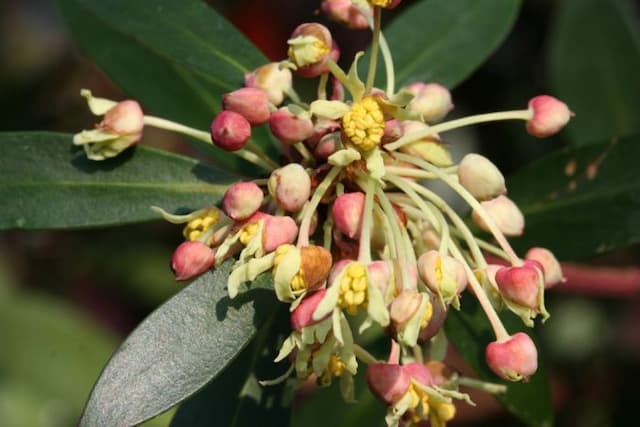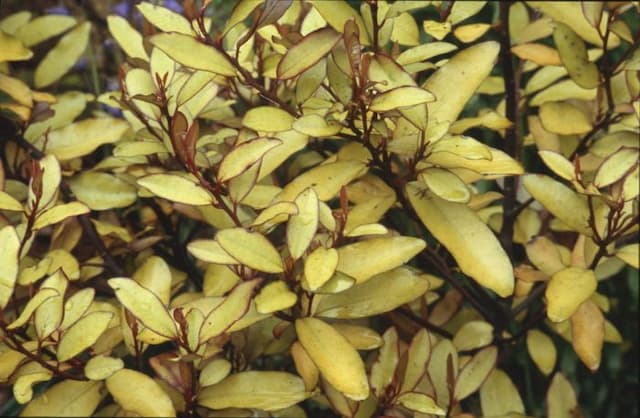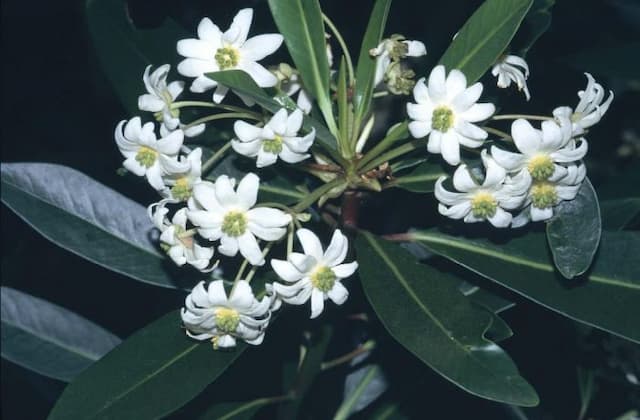Pepper tree 'Red Leopard' Pseudowintera colorata 'Red Leopard'

ABOUT
Pittosporum 'Red Leopard' is an evergreen shrub to 1m tall, with elliptic leaves to 6cm long, yellowish-green heavily blotched and spotted with dark, brownish red. Greenish-yellow cup-shaped flowers 1cm across open in spring, followed by small red, later black, berries
About this plant
 Names
NamesFamily
Winteraceae
Synonyms
Red Leopard Horopito, Pepper Tree, New Zealand Pepper Tree
Common names
Drimys colorata, Wintera colorata.
 Characteristics
CharacteristicsLife cycle
Perennials
Foliage type
Evergreen
Color of leaves
Variegated
Flower color
Yellow
Height
5 feet [1.5 meters]
Spread
5 feet [1.5 meters]
Plant type
Shrub
Hardiness zones
8
Native area
New Zealand
Benefits
 General Benefits
General Benefits- Ornamental Appeal: 'Red Leopard' adds vibrant color and visual interest to gardens with its red-marbled foliage.
- Habitat Support: It provides habitat and food for native insect species, contributing to local biodiversity.
- Drought Resistance: Once established, 'Red Leopard' has good tolerance for dry conditions, reducing the need for frequent watering.
- Low Maintenance: This plant typically requires minimal care once established, making it a good choice for low-maintenance landscaping.
- Frost Tolerance: It can tolerate frosts, which allows it to be grown in a variety of climates.
- Size Control: The slow growth rate and manageable size make it suitable for small gardens or as a container plant.
- Privacy: When planted in groups, 'Red Leopard' can provide a level of privacy as a screening plant.
- Erosion Control: Its root system can help stabilize soil and control erosion on slopes or in areas prone to soil degradation.
- Seasonal Interest: Provides year-round interest due to its evergreen nature and seasonal changes in leaf color.
- Wildlife Attraction: The flowers and berries can attract birds and beneficial insects to the garden.
 Medical Properties
Medical Properties- Antimicrobial: Pseudowintera colorata contains compounds that may have antimicrobial effects against certain pathogens.
- Antifungal: May have properties that inhibit the growth of fungi.
- Antioxidant: Potential to contain high levels of antioxidants, which can help neutralize harmful free radicals in the body.
- Anti-inflammatory: Compounds within the plant might possess anti-inflammatory properties, helpful in reducing inflammation.
- Analgesic: There could be components that act as pain relievers.
 Air-purifying Qualities
Air-purifying QualitiesThis plant is not specifically known for air purifying qualities.
 Other Uses
Other Uses- Pseudowintera colorata 'Red Leopard', or Horopito, can be used as a natural insect repellent when crushed leaves are rubbed onto the skin.
- Horopito leaves have been used as a flavoring agent in culinary applications, imparting a peppery taste to dishes.
- The pigmented leaves of Horopito can also serve as a natural dye for textiles, giving fabrics a unique coloration.
- Indigenous Maori would use Horopito leaves to preserve stored food, due to their antifungal properties.
- Horopito leaf extract is sometimes used in cosmetics, especially in creams and lotions, for its fragrance and potential skin benefits.
- In arts and crafts, Horopito leaves could be integrated into papermaking for decorative purposes.
- Horopito can also be used in landscaping as a means of companion planting to deter pests from other plants.
- The wood of Pseudowintera colorata 'Red Leopard' is durable and has been used in woodworking for making small objects or inlays.
- Horopito can be added to homemade potpourri blends for its vibrant leaf colors and aromatic properties.
- The plant has potential uses in environmental management, such as stream bank stabilization due to its root system.
Interesting Facts
 Feng Shui
Feng ShuiThe Horopito is not used in Feng Shui practice.
 Zodiac Sign Compitability
Zodiac Sign CompitabilityThe Horopito is not used in astrology practice.
 Plant Symbolism
Plant Symbolism- Resilience: The Pseudowintera colorata 'Red Leopard', commonly known as Horopito, is a plant known for its ability to thrive in tough environmental conditions, hence it represents resilience and the ability to overcome adversity.
- Endemic Pride: As Horopito is native to New Zealand and not found naturally elsewhere, it symbolizes the unique beauty and pride of the indigenous flora and fauna of a particular region.
- Healing: Traditionally used by Maori for medicinal purposes, Horopito has come to symbolize healing and the importance of natural remedies derived from plants.
- Spiciness: With its spicy, peppery leaves, Horopito can symbolize a zest for life, excitement, and adding "flavor" to experiences.
- Adaptability: Given its adaptability to different soil types and conditions, Horopito represents the ability to adjust to varying circumstances and environments.
 Water
WaterHoropito, commonly known as 'Red Leopard', thrives when watered evenly and allowed to slightly dry out between waterings. Generally, a watering frequency of once a week is adequate, although this may vary depending on the plant's environment and potting medium. Apply approximately 16 to 32 ounces of water, ensuring to saturate the soil evenly without causing waterlogging. During the hotter seasons, the plant may require more frequent watering, while it needs less in the cooler months. Ensure proper drainage to prevent root rot.
 Light
LightHoropito prefers a location with bright, indirect light to achieve optimal growth. Placing 'Red Leopard' in an east- or west-facing window where it can receive gentle morning or evening sunlight is ideal. Direct midday sun may be too intense and could cause leaf burn, so it should be avoided.
 Temperature
TemperatureHoropito 'Red Leopard' is comfortable in a range of temperatures, typically preferring conditions between 50 to 68 degrees Fahrenheit. The plant can withstand brief dips down to as low as 23 degrees Fahrenheit but should not be subjected to prolonged cold spells. Ideal growing conditions are achieved within the moderate temperature range, avoiding extremes of heat or cold.
 Pruning
PruningHoropito 'Red Leopard' benefits from light pruning to maintain its shape and encourage bushier growth. The best time to prune is in the late winter or early spring, just before new growth begins. Remove any dead or damaged branches, and cut back up to one-third of the plant to stimulate fresh growth. Pruning should be done annually or as needed to keep the plant looking its best.
 Cleaning
CleaningAs needed
 Soil
SoilThe New Zealand Pepper Tree prefers a soil mix that is well-draining with high organic matter content. A blend of 50% potting soil, 30% perlite, and 20% compost would be ideal, aiming for a slightly acidic to neutral pH between 5.5 and 7.0.
 Repotting
RepottingThe New Zealand Pepper Tree should generally be repotted every 2 to 3 years or when it has outgrown its current pot, ensuring to refresh the soil mix to maintain nutrient availability and soil structure.
 Humidity & Misting
Humidity & MistingThe New Zealand Pepper Tree thrives in moderate to high humidity levels, ideally around 60-80%. It is important to maintain consistent humidity without letting the environment become too soggy or dry.
 Suitable locations
Suitable locationsIndoor
Provide bright, indirect light and maintain moderate humidity.
Outdoor
Plant in partial shade, sheltered from extreme elements.
Hardiness zone
8-11 USDA
 Life cycle
Life cycleHoropito (Pseudowintera colorata 'Red Leopard') begins its life as a seed, which upon germination, grows into a small seedling. In the juvenile stage, the seedling develops a root system and distinctive red-speckled, green leaves. As it matures, the horopito enters the vegetative stage, where it continues to grow in size and produce more foliage. After reaching maturity, it enters the reproductive stage where it develops small, inconspicuous greenish-white flowers, usually hidden beneath the leaves. Fertilized flowers then produce tiny black fruit, each containing seeds for the next generation. The plant can also spread vegetatively through underground rhizomes, leading to the growth of new plants nearby, and it continues this life cycle for many years as a perennial.
 Propogation
PropogationPropogation time
Spring-Early Summer
Pseudowintera colorata 'Red Leopard', commonly known as Red Leopard horopito, can be propagated through semi-hardwood cuttings. The ideal time to take cuttings for propagation is during late summer to early autumn when the plant's growth has slowed and the current season's growth has begun to harden. To propagate, select healthy semi-hardwood stems from the Red Leopard horopito, cutting sections that are 4 to 6 inches (10 to 15 centimeters) long with several leaves attached. The lower leaves should be removed and the cut end dipped in rooting hormone to encourage root growth. The prepared cuttings are then placed in a well-draining potting mix and kept in a warm, humid environment with indirect sunlight. Covering the pot with a plastic bag can help maintain humidity levels. Roots typically develop within several weeks, after which the new plants can be transferred to individual pots and eventually planted out into the garden when they are well-established.




